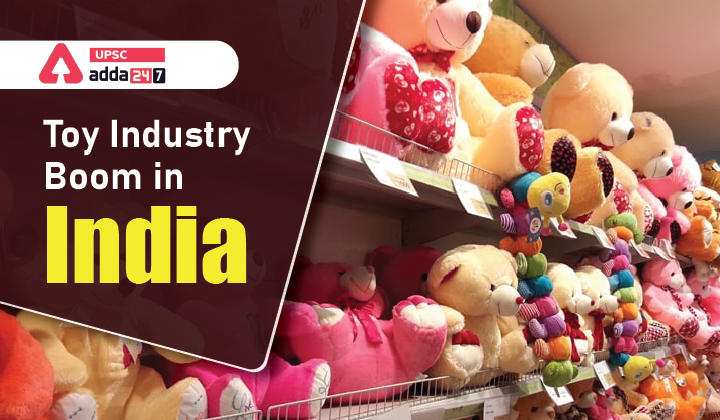Table of Contents
Toy industry of India: Relevance
- GS 3: Indian Economy and issues relating to planning, mobilization, of resources, growth, development and employment.
Toy manufacturing in India: Context
- Recently, Ministry of Commerce & Industry has informed that the import of toys is down by 70% in the last three years, showing the robust growth of toy sector in India.
Toy sector growth in India
- The Indian toys market reached a value of US $1.35 billion in 2021.
- The toy market is projected to reach US $2.73 billion by 2027, showing a CAGR of 12.6% during 2022-2027.
- According to a FICCI-KPMG report, the Indian toy market, which is currently estimated at $1 billion, has the potential to double itself by 2025.
- There is high growth potential for India in exports of plastic toys and board games in the US, EU and Middle East among other markets.
Key drivers of toy sector growth
- Huge consumer base: With a population of around 1.3 billion, India is the second largest populated country in the world. Moreover, the country has a very large young population with around half of the total population under the age of 25.
- Rising disposable income: The increasing domestic demand for toys in India is also being catalysed by the country’s strong economic growth and rising disposable incomes.
- Historical connection: The existence of toys in India dates back to the Indus Valley Civilization around five thousand years ago.
- While the earlier toys were made from materials found in nature such as sticks, clay and rocks, the advent of advanced technology and machinery has encouraged manufacturers to produce modern and innovative toys.
- Diversity of toys: There is a huge diversity in toys. While some are made by the MSMEs, others are made by the big companies. The price of toys also has a wide range.
- Based on gender, unisex toys dominate the Indian toys market, accounting for the majority of the overall market share. Unisex toys are followed by girls’ and boys’ toys.
- Online sales: Online sales channels have also recently witnessed a boom in India with the evolution of smartphones and other digital media. With the kind of internet penetration in India, online sales channels have appeared to be one of the fastest growing distribution channels for toys in India.
Government steps for toy sector
- Directorate General of Foreign Trade (DGFT) mandated sample testing of each consignment and no permission for sale unless the quality testing is successful. In case of failure, the consignment is either sent back or destroyed at the cost of the importer.
- Basic Custom Duty (BCD) on Toys has been increased from 20% to 60% in February, 2020.
- The Government issued Toys (Quality Control) Order, 2020 through which toys have been brought under compulsory Bureau of Indian Standards (BIS) certification.
- BIS made special provisions in so as to grant license to micro scale units manufacturing toys without testing facility for one year and not to insist on establishing in-house facility.
- BIS has granted 843 licenses to domestic manufacturers from safety of toys, out of these, 645 licenses have been granted for non-electric toys and 198 licenses granted for electric toys. In addition to this, 6 licenses have been granted to international toy manufacturers.
Read current affairs for UPSC





 TSPSC Group 1 Question Paper 2024, Downl...
TSPSC Group 1 Question Paper 2024, Downl...
 TSPSC Group 1 Answer key 2024 Out, Downl...
TSPSC Group 1 Answer key 2024 Out, Downl...
 UPSC Prelims 2024 Question Paper, Downlo...
UPSC Prelims 2024 Question Paper, Downlo...




